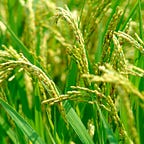Integrated Harvesting Techniques for African Egg Plant (Solanum macrocarpon L., cv. Igbagba) | Chapter 02 | Advances and Trends in Agricultural Sciences Vol. 2
Aim: This study elucidated the influence of harvesting height and frequency on concurrent seed and shoots production of the African Eggplant, Solanum macrocarpon L., cv. Igbagba/Igbo. The overall aim was to use the outcome to make recommendations that would enable African resource poor farmers secure the much needed increase in income for improved livelihoods.
Experimental Design: The experiment was a three (harvesting heights of 0.04 m, 0.08 m and 0.12 m) by five (harvesting frequencies of 1x per 1,2,3,4 and 5 weeks) factorial treatment arrangements fitted into randomized complete block with 4 replications. There was a control treatment which was harvested at ground level six weeks after planting for vegetative yield estimation and a check which was left for seeding without cutting. Net plot size was 5 m x 5 m (25 m2).
Place and Duration of Study: The study was carried out between April to November 2004 on the National Horticultural Research Institute (NIHORT) Ibadan, Nigeria commercial vegetable production fields.
Methodology: Cumulative shoot fresh weight over the cutting period gave the shoot yield per plant. S. macrocarpon fruits were harvested, processed for seed and the seed weighed at 12% moisture content. Seed and shoot yield values were based on current NIHORT [National Horticultural Research Institute, Nigeria] prices of N450.00 per kilogram seed and N10.00 per kilogram shoot (US$1 = N80 at time of data collection, N is Nigerian Currency). Harvest index was calculated as seed weight/shoot weight which indicates changes in the pattern of dry matter partitioning into seed and shoot. Cutting Use Efficiency (CUE) was defined as the relative agronomic efficiency of using cutting over the control. Data were subjected to analyses of variance by the procedure of the Statistical Analysis System (SAS, 2005) using mean of 10 plants per treatment plot. Marginal revenue (MR) equals field price per kilogram multiplied by average yield (kg/ha) where field price is the market value of one kilogram of the crop. Marginal cost (MC) included those costs that are affected by the alternative treatment being considered (costs such as planting, land purchase, land preparation and transport that do not differ across treatments will be incurred regardless of which treatments is used). Data from both seasons (long cropping season and short cropping season) for each treatment were combined because there were no seasonal significant differences. Means were compared using Duncan’s Multiple Range Test (DMRT) at 5% significance.
Results: Shows that harvesting at 0.08 m above ground level was optimal and significantly highest for leaf, stem, shoot, seed and total yields except at 0.12 m above ground level for seed production. The result of financial profitability analysis shows that harvesting 0.08 m above ground level and fortnightly was most profitable for leaf, shoot and total yields compared to all the treatment combinations. Harvesting 0.12 m above ground level and monthly, however, was most profitable for seed production when compared to all treatments combinations.
Conclusion: The study concluded noting that integrated harvesting techniques for shoot (leaf + stem) and seed production proved economically viable and optimize resource use efficiency better than growing S. macrocarpon sole either for shoot or seed.
Author(s) Details
David O. Ojo (PhD),
NIHORT, PMB 5432, Idi Ishin, Ibadan, Oyo State, Nigeria.
Joseph T. Atobatele
College of Staten Island, 2800 Victory Boulevard, Staten Island, New York 10314 718.982.2000, United States of America.
Jonas N. Chianu
Tropical Soil Biology and Fertility Institute of Centro Internacional Agricultura de Tropicale (TSBF-CIAT), World Agroforestry Centre (ICRAF), Nairobi, Kenya.
Read full article: http://bp.bookpi.org/index.php/bpi/catalog/view/76/1014/718-1
View Volume: https://doi.org/10.9734/bpi/atias/v2
